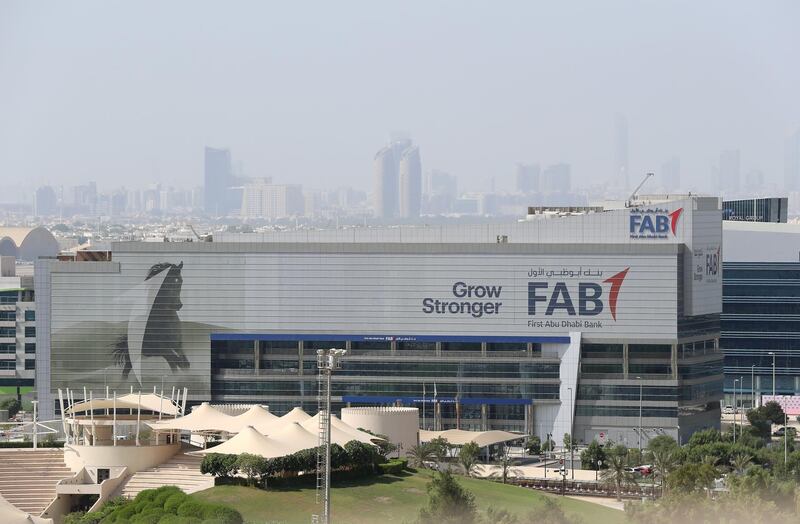First Abu Dhabi Bank (FAB), the lender created last year from the coming together of National Bank of Abu Dhabi and First Gulf Bank, released its first set of post-merger annual results on Monday. In this week’s column, I’ll be looking at the bank’s pro-forma statements from both last year and 2016, analysing how well the new institution has been doing thus far.
In 2017, FAB’s loans and advances – the bank’s largest asset component - decreased by about Dh4 billion compared with 2016; this is puzzling, as the usual logic of a merger is to grow your main business line, rather than see it shrink. To be fair, in percentage terms it’s a decrease of just 1 per cent.
The bank’s cash pile increased 12 per cent to Dh138bn from Dh123bn over the period, representing about 21 per cent of the bank’s balance sheet. Since cash yields next to nothing, to have such a large repository is unexpected
In short, these headline numbers seem to challenge the concept of last year’s strategic merger, as mergers are usually entered into as part of a growth strategy.
Let’s look at the picture from a few different angles and see if we can make sense of it.
As I’ve mentioned before, the growth of interest income for a bank relative to interest expense is a core performance measure to look out for. In 2017 FAB’s interest income grew 0.9 per cent year on year, whilst its interest expense grew about 12 per cent. That is not a good sign. More ominously, high quality fee and commission income dropped 10 per cent, whilst fee and commission expenses remained stable.
These profit and loss trends are consistent with what we saw in the balance sheet. One saving grace was the 60 per cent year-on-year rise in income from investments and derivatives. But such an increase is not sustainable.
Looking at the expense side, there is little change on the general, administration and other operating expenses. In a merger you would expect savings in this area, but over the course of two to three years, so this line item seems fine. Impairments meanwhile dropped 10 per cent, consistent with general economic conditions. FAB’s net profit for the year dropped about 4 per cent.
_______________
Read more from Sabah al-Binali:
[ Good acquisitions, an unfit brand, and Abu Dhabi's rising international reputation ]
Donald Trump applies winning business strategies to his US presidential campaign
_______________
To round out the high level picture (we’ll get into details below), just two points on the liabilities. Customer deposits increased 4 per cent to Dh396bn from Dh379bn, which doesn’t make sense if you are lending less.
Term borrowing dropped around 10 per cent year on year to Dh42bn from Dh47bn. Term borrowings usually cost more than deposits but are safer as they are longer-term. The actual size of term borrowings for FAB is small relative compared with customer deposits, but it does seem to be going the wrong way around. I can’t read the minds of FAB’s asset-liability committee, but widening the bank’s asset-liability gap doesn’t seem like the optimal decision.
This leads us nicely to some of the details behind the headline numbers. As noted above, interest expense grew 12 per cent or by about Dh600 million. Term borrowing contributed about Dh270m to that increase. This makes sense; the US Fed raised interest rates in 2017, and the bank’s term borrowings, probably paying a floating interest rate directly or through a hedge, would therefore increase as a result. But that is the cost of securing long-term funding. Allowing long-term borrowings to fall away to keep expenses down, but at the same time increasing the asset-liability gap, might not be the way to go.
The interest expense attributable to customer deposits increased 16 per cent to Dh3bn from Dh2.6bn. Recall that the actual deposits themselves grew by just 4 per cent. It seems therefore that FAB paid a lot more during the past year to acquire extra customer deposits, which they then proceeded to hold in cash.
If FAB had a liquidity crunch, then perhaps they would need to increase their deposit rates so much. But with 21 per cent of the balance sheet in cash and central bank balances, why raise rates so much? Even for a former bank treasurer like me, it’s hard to fathom.
It’s still early days for FAB, with the dust still settling following the completion of the merger in April. But the bank needs to address questions about its stagnant loan book, its high cash balance and the high cost of customer deposits if it’s going to convince investors that it has a winning strategy.






